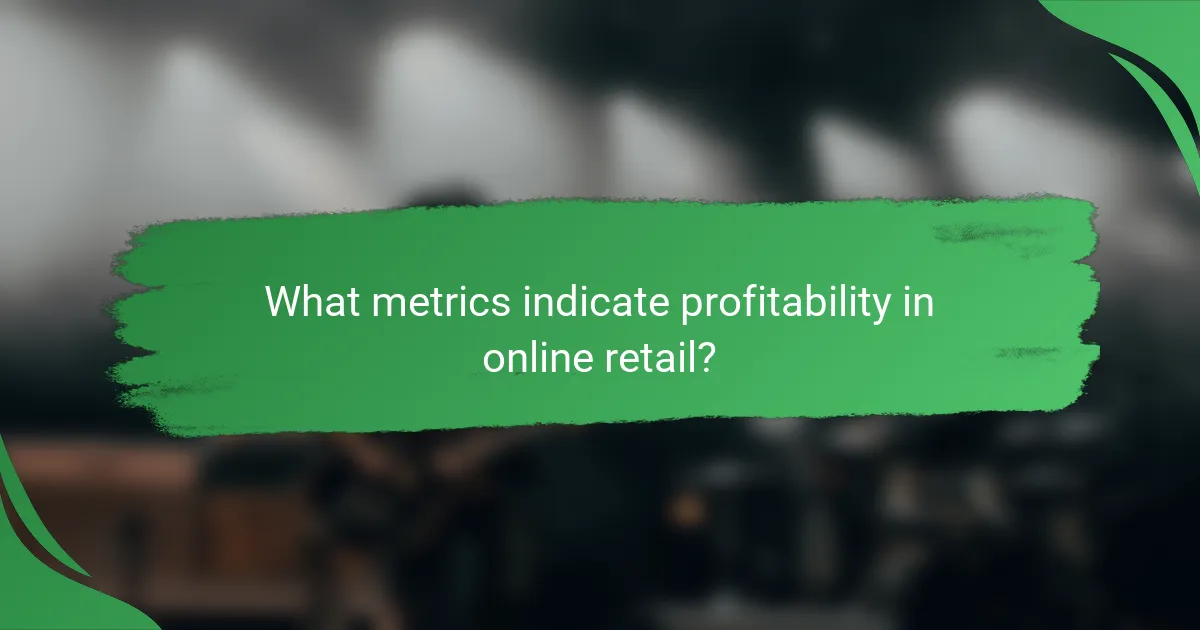Understanding financial metrics such as viability, profitability, and sustainability is crucial for e-commerce businesses aiming for long-term success. By evaluating key performance indicators and market conditions, companies can assess their ability to generate sustainable profits while managing costs effectively. Additionally, measuring sustainability through environmental and social impacts provides a holistic view of a business’s overall health and responsibility.

How to assess financial viability for e-commerce businesses?
To assess financial viability for e-commerce businesses, focus on evaluating their ability to generate sustainable profits while managing costs effectively. This involves analyzing key performance indicators, conducting market analysis, and evaluating the cost structure to ensure long-term success.
Key performance indicators
Key performance indicators (KPIs) are essential metrics that help gauge the financial health of an e-commerce business. Common KPIs include gross profit margin, customer acquisition cost, and return on investment. Monitoring these metrics allows businesses to identify trends and make informed decisions.
For example, a gross profit margin of 40-60% is often considered healthy for e-commerce. Keeping customer acquisition costs low, ideally below 30% of the customer lifetime value, can enhance profitability.
Market analysis techniques
Market analysis techniques involve assessing the competitive landscape and understanding customer needs. Tools such as SWOT analysis (Strengths, Weaknesses, Opportunities, Threats) and Porter’s Five Forces can provide insights into market dynamics and potential profitability.
Conducting surveys and analyzing customer feedback can also help identify gaps in the market. This information is crucial for tailoring products and marketing strategies to meet consumer demands effectively.
Cost structure evaluation
Evaluating the cost structure involves analyzing fixed and variable costs associated with running an e-commerce business. Fixed costs include website hosting and salaries, while variable costs may encompass shipping and inventory expenses. Understanding these costs helps in pricing strategies and budget allocation.
A practical approach is to aim for a cost of goods sold (COGS) that is no more than 30-40% of total revenue. Regularly reviewing and optimizing these costs can lead to improved margins and overall financial viability.

What metrics indicate profitability in online retail?
Key metrics that indicate profitability in online retail include gross profit margin, net profit margin, and return on investment. These metrics help assess the financial health and efficiency of an online business, guiding strategic decisions to enhance profitability.
Gross profit margin
Gross profit margin measures the difference between sales revenue and the cost of goods sold (COGS), expressed as a percentage of sales. It indicates how efficiently a company uses its resources to produce and sell products. A healthy gross profit margin typically ranges from 20% to 50%, depending on the industry.
To calculate gross profit margin, use the formula: (Sales Revenue – COGS) / Sales Revenue x 100. For example, if an online retailer has sales of $100,000 and COGS of $60,000, the gross profit margin would be 40%. Monitoring this metric helps identify pricing strategies and cost management opportunities.
Net profit margin
Net profit margin reflects the percentage of revenue that remains as profit after all expenses, including operating costs and taxes, are deducted. This metric provides a comprehensive view of overall profitability and financial performance. A net profit margin of 5% to 15% is generally considered good for online retailers.
To calculate net profit margin, apply the formula: Net Income / Sales Revenue x 100. For instance, if an online store generates $200,000 in revenue and incurs total expenses of $180,000, the net profit margin would be 10%. Regularly assessing this metric can highlight areas for cost reduction and revenue enhancement.
Return on investment
Return on investment (ROI) gauges the profitability of investments relative to their costs. It is crucial for evaluating the effectiveness of marketing campaigns, inventory purchases, and other expenditures in online retail. A positive ROI indicates that the investment generates more revenue than it costs.
To calculate ROI, use the formula: (Net Profit from Investment – Cost of Investment) / Cost of Investment x 100. For example, if a retailer spends $10,000 on a marketing campaign and earns an additional $15,000 in profit, the ROI would be 50%. Tracking ROI helps prioritize investments that yield the highest returns and informs future budgeting decisions.

How to measure sustainability in e-commerce?
Measuring sustainability in e-commerce involves evaluating environmental, social, and economic impacts. Key metrics include carbon footprint, social responsibility, and long-term financial viability, which together provide a comprehensive view of a business’s sustainability efforts.
Environmental impact assessments
Environmental impact assessments (EIAs) evaluate the ecological consequences of e-commerce operations. This includes measuring carbon emissions from shipping, energy consumption of data centers, and waste management practices. Tools like Life Cycle Assessment (LCA) can help quantify these impacts.
For practical assessment, businesses can track metrics such as the percentage of recyclable packaging used or the carbon footprint per product sold. Setting targets to reduce emissions by specific percentages over time can also guide sustainability efforts.
Social responsibility metrics
Social responsibility metrics focus on the ethical implications of e-commerce practices. This includes fair labor practices, community engagement, and customer satisfaction. Companies should assess their supply chains to ensure fair wages and safe working conditions.
Common metrics include employee turnover rates, customer feedback scores, and community investment levels. Establishing a code of conduct for suppliers and regularly auditing compliance can enhance social responsibility.
Long-term financial health indicators
Long-term financial health indicators assess the sustainability of a business’s economic practices. Key metrics include profit margins, return on investment (ROI), and cash flow stability. These indicators help determine if a company can sustain its operations while investing in sustainable practices.
Businesses should monitor trends in revenue growth linked to sustainable products and practices. Additionally, evaluating the cost savings from energy-efficient operations can provide insights into financial sustainability. Regular financial reviews can identify areas for improvement and ensure alignment with sustainability goals.

What frameworks support financial decision-making?
Several frameworks assist in financial decision-making by providing structured approaches to evaluate business viability, profitability, and sustainability. These frameworks help organizations assess their internal and external environments, set strategic objectives, and measure performance effectively.
SWOT analysis for e-commerce
SWOT analysis is a strategic planning tool that evaluates the Strengths, Weaknesses, Opportunities, and Threats related to an e-commerce business. This framework helps identify internal capabilities and external market conditions that can impact financial performance.
For example, a strong online presence (strength) can attract more customers, while limited payment options (weakness) may hinder sales. Opportunities such as emerging markets or trends in consumer behavior can be leveraged, while threats like increasing competition or regulatory changes must be monitored.
Balanced scorecard approach
The balanced scorecard approach translates an organization’s strategic goals into a set of performance metrics across four perspectives: financial, customer, internal processes, and learning and growth. This framework ensures that financial decision-making aligns with broader business objectives.
For instance, a company might track financial metrics like revenue growth alongside customer satisfaction scores and employee training initiatives. This holistic view allows businesses to balance short-term financial performance with long-term sustainability and innovation.

How do financial metrics influence e-commerce strategy?
Financial metrics play a crucial role in shaping e-commerce strategies by providing insights into viability, profitability, and sustainability. These metrics help businesses make informed decisions regarding pricing, investment, and overall operational efficiency.
Pricing strategy adjustments
Effective pricing strategies are essential for maximizing profitability and ensuring market competitiveness. Businesses should regularly analyze financial metrics such as gross margin and customer acquisition cost to determine optimal pricing points. For instance, if the gross margin is declining, it may be necessary to adjust prices or reduce costs.
Consider implementing dynamic pricing models that adjust based on demand, competition, and inventory levels. This approach can help maintain profitability while responding to market changes. However, be cautious of overpricing, which can lead to lost sales, or underpricing, which can erode profit margins.
Investment in technology
Investing in technology is vital for enhancing operational efficiency and customer experience in e-commerce. Financial metrics can guide these investments by highlighting areas where technology can reduce costs or increase revenue. For example, if data shows high cart abandonment rates, investing in user-friendly checkout software could improve conversion rates.
When evaluating technology investments, consider the potential return on investment (ROI) and payback period. A common heuristic is to aim for an ROI of at least 20-30% within the first year. Additionally, prioritize scalable solutions that can grow with your business, ensuring long-term sustainability.

What are emerging trends in financial metrics for e-commerce?
Emerging trends in financial metrics for e-commerce focus on integrating advanced technologies and sustainable practices to enhance profitability and operational viability. Key areas include the use of AI for financial analysis, the adoption of circular economy metrics, and the implementation of real-time reporting tools.
Integration of AI in financial analysis
The integration of AI in financial analysis allows e-commerce businesses to process vast amounts of data quickly and accurately. AI algorithms can identify patterns and trends that human analysts might miss, enabling more informed decision-making.
For instance, predictive analytics can forecast sales trends based on historical data, helping businesses adjust inventory and marketing strategies accordingly. Companies should consider investing in AI tools that offer customizable dashboards and reporting features to maximize insights.
Focus on circular economy metrics
Focusing on circular economy metrics helps e-commerce businesses measure their sustainability efforts and resource efficiency. These metrics assess how products are reused, recycled, or repurposed, which can enhance brand reputation and customer loyalty.
Examples of circular economy metrics include the percentage of materials sourced sustainably and the rate of product returns that are refurbished. Companies should aim to track these metrics regularly to identify areas for improvement and align with consumer demand for environmentally friendly practices.
Real-time financial reporting tools
Real-time financial reporting tools provide e-commerce businesses with up-to-date insights into their financial health. These tools enable companies to monitor key performance indicators (KPIs) instantly, allowing for quicker adjustments to strategies and operations.
Implementing tools that integrate with existing e-commerce platforms can streamline data collection and reporting. Businesses should prioritize solutions that offer customizable reporting features to focus on metrics that matter most to their specific goals.


